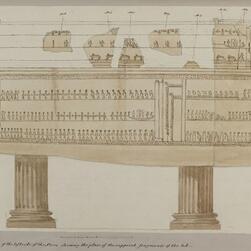Two centuries ago, the largest Ancient Egyptian tomb in the Valley of the Kings was discovered. Inside was the magnificent alabaster sarcophagus of a King. Here, curator of our current exhibition Egypt Uncovered, Jo Tinworth, talks about the day it was found.
Two hundred years ago today (19 Oct 2017) Giovanni Belzoni, a flamboyant circus strongman, turned engineer, turned explorer, discovered the sarcophagus of Pharaoh Seti I (1290-1279 BC), in the Valley of the Kings in Egypt.
Three days earlier he had begun digging and quickly discovered the entrance to ‘a magnificent tomb’ the largest and most elaborately decorated in the Valley at that time. Belzoni wrote about the tomb in his travel diary, evocatively describing the spaces he entered as ‘the Room of Beauties’, ‘the Room of Mysteries’, ‘the Bull’s Room’ and the paintings which densely covered the walls of the tomb as ‘more perfect as we advanced farther into the interior. They retained their gloss or a kind of varnish over the colours which had a beautiful effect.’
The most ornate of all the chambers was the sarcophagus hall. Here Belzoni found ‘not having its equal in the world, and being such as we thought could never exist … a sarcophagus of the finest oriental alabaster … it is transparent when a light is placed inside it … minutely sculptured within and without with several hundred figures which represent, as I suppose, the whole of the funeral procession relating to the deceased.’ In this last point, Belzoni was wrong; the hieroglyphic engraving on the sarcophagus depicts the Book of Gates which describes how, according to Egyptian funerary mythology, the Pharaoh could be reborn (as Egyptians believed the sun was reborn every morning) as long as he closely followed the hazardous journey of the sun god Re as he passed through the netherworld of the night. Belzoni was right however that the sarcophagus had no equal: two-hundred years later it remains one of the most important antiquities to have been discovered in Egypt.
The sarcophagus, was a source of fascination for Sir John Soane who followed Belzoni’s travels with interest. In 1824 when the Trustees of the British Museum decided it was too expensive for them to purchase, Sir John Soane paid £2,000 for the sarcophagus, knocked a hole in the rear wall of his house, 13 Lincoln’s Inn Fields to get it in and made it the centrepiece of his collection in the Sepulchral Chamber where it still sits today.
In 1825, Soane held three parties to which he invited the cream of London society to view the sarcophagus in the evening lit by lamplight, and illuminated from within. The design of the lighting was supervised by Soane himself, contrasting light and shadow to create an atmosphere thick with romance and melancholy. The impression it made in the basement of his Museum prompted the author Barbara Hofland to write that seen by lamplight ‘every surrounding object … becomes subservient to the sarcophagus … all are but accessories to its dignity and grandeur.’
We're celebrating the bicentenary of the discovery in our current exhibition Egypt Uncovered: Belzoni and the Sarcophagus of Pharoah Seti I (until 15 April 2018, admission free). It has been so exciting to curate this show and to tell this fascinating story of Sir John Soane's most treasured possession through a mix of objects from our collection and important loans from places including the British Museum and Bristol Museum and Art Gallery. We've also brought the story right up to date with new research, and there's a specially commissioned video produced from digital rendering of the sarcophagus, allowing a close-up, large-scale view of the detailed inscriptions. We can only speculate on what Belzoni would make of this!
Read more about in the exhibition's accompanying book Sir John Soane’s Greatest Treasure The Sarcophagus of Seti I, now avalable in the Soane Shop and online.




